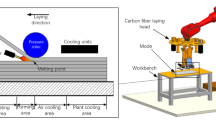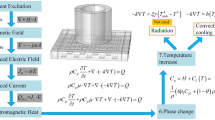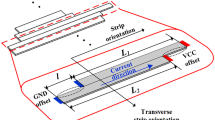Abstract
Induction welding is a suitable and promising technique for assembling thermoplastic composite structural components. In this work, a magneto-thermal coupling model has been developed to simulate the induction welding process of carbon fiber–reinforced thermoplastic composite L-shaped stringers. To verify the accuracy and applicability of this model, a series of experiments were conducted, and an infrared thermometer was utilized to calibrate the simulation temperature field. The accuracy and applicability of the model for the induction welding process were validated by comparing the experimental results with the simulated results. Specifically, the induced current density and the magnetic field distribution during induction heating were examined, and the temperature distribution of the carbon fiber–reinforced thermoplastic composite L-shaped stringers during heating was analyzed. It was found that the temperature field on the induction element was distributed in a semi-elliptical shape, extending from the boundary to the middle and intersecting in a butterfly shape at the center. Furthermore, the evolution of the temperature field under different process parameters was investigated, focusing on the influence of coil current and heating time. Based on the simulation results, the optimum process parameters were the coil current of 4 A and the heating time of 40 s.
















Similar content being viewed by others
Data availability
Data and materials are available.
Code availability
Not applicable.
References
Choudhury MR, Debnath K (2019) A review of the research and advances in electromagnetic joining of fiber-reinforced thermoplastic composites. Polym Eng Sci. 59:1965–1985. https://doi.org/10.1002/pen.25207
Lm T, Kwon Y, Choi S, Shon M, Jeon H, Oh S, Kim G (2020) Heating behavior and adhesion performance of induction-heated multilayered thermoplastic polyurethane adhesive film. J Adhes. 96:1186–1197. https://doi.org/10.1080/00218464.2019.1565757
Nele L, Palmieri B (2020) Electromagnetic heating for adhesive melting in CFRTP joining: study, analysis, and testing. Int J Adv Manuf Technol. 106:5317–5331. https://doi.org/10.1007/s00170-019-04910-9
Arquier R, Iliopoulos I, Régnier G, Miquelard-Garnier G (2022) Consolidation of continuous-carbon-fiber-reinforced PAEK composites: a review. Mater Today Commun. 32:104036. https://doi.org/10.1016/j.mtcomm.2022.104036
Wang F, Luo J, Zhang P, Liu X, Zhan X (2023) Effect of thickness of carbon fiber susceptor on mechanical property and fracture mode of carbon fiber reinforced thermoplastic composite induction welded joint. Acta Mater Compos Sin. 40(4):2405–2414. https://doi.org/10.13801/j.cnki.fhclxb.20220618.001
Pappadà S, Salomi A, Montanaro J, Passaro A, Caruso A, Maffezzoli A (2015) Fabrication of a thermoplastic matrix composite stiffened panel by induction welding. Aerosp Sci Technol. 43:314–320. https://doi.org/10.1016/j.ast.2015.03.013
Wang F, Ma W, Zhan X, Zhang P, Bu H (2020) Comparative study on the morphology and mechanical strength of induction welding joint of polyetheretherketone under different currents. Polym Eng Sci. 60:2908–2917. https://doi.org/10.1002/pen.25522
Hagnell MK, Langbeck B, Åkermo M (2016) Cost efficiency, integration and assembly of a generic composite aeronautical wing box. Compos Struct. 152:1014–1023. https://doi.org/10.1016/j.compstruct.2016.06.032
Borba NZ, dos Santos JF, Amancio-Filho ST (2021) Hydrothermal aging of friction riveted thermoplastic composite joints for aircraft applications. Compos Struct. 255:112871. https://doi.org/10.1016/j.compstruct.2020.112871
Rao Z, Ou L, Wang Y, Wang P-C (2020) A self-piercing-through riveting method for joining of discontinuous carbon fiber reinforced nylon 6 composite. Compos Struct. 237:111841. https://doi.org/10.1016/j.compstruct.2019.111841
Fathi P, Petrudi AM, Scurtu IC (2021) Investigation of the effects of drilling on mechanical joints in composite structures. IOP Conf Ser Earth Environ Sci. 635:012010. https://doi.org/10.1088/1755-1315/635/1/012010
Zhou L, Qin Z, Liu S, Chen W, Li G, Song X, Feng J (2019) Progress on joining technology of thermoplastic resin matrix composites. Mater Rep. 33(19):3177–3183. https://doi.org/10.11896/cldb.18090151
Ho MP, Wai HW, Tam WY, Leung M (2020) The effect of laser treatment on the secondary bonding behavior of carbon fibre composite. Key Eng Mater. 845:27–32. https://doi.org/10.4028/www.scientific.net/KEM.845.27
Hu C, Hou Y, Tie Y, Li C, Mao Z (2021) Influence of different bonding parameters on the strength of CFRP laminates with single lap bonding structure and optimization. J Mech Eng. 57(8):154–165. https://doi.org/10.3901/JME.2021.08.154
Bu H, Li Y, Yang H, Wang L, Zhan X (2020) Investigation of laser joining process of CFRTP and aluminum alloy. Mater Manuf Process. 35:1251–1258. https://doi.org/10.1080/10426914.2020.1762205
Bu H, Li X, Li B, Li X, Zhan X (2023) Enhanced interfacial joining strength of laser wobble joined 6061-T6 Al alloy/CFRTP joint via interfacial bionic textures pre-construction. Compos Part B. 261:110787. https://doi.org/10.1016/j.compositesb.2023.110787
Bu H, Zhan X, Yang H, Wang F Ma W (2022) Numerical simulation of thermal distribution and residual stress characteristic for laser wobble joining of CFRTP and Ti-6Al-4V alloy. J Manuf Process. 79:562–575. https://doi.org/10.1016/j.jmapro.2022.05.018
Ahmed TJ, Stavrov D, Bersee HEN, Beukers A (2006) Induction welding of thermoplastic composites—an overview. Compos A: Appl Sci Manuf. 37:1638–1651. https://doi.org/10.1016/j.compositesa.2005.10.009
Villegas IF, Moser L, Yousefpour A, Mitschang A, Bersee HEN (2013) Process and performance evaluation of ultrasonic, induction and resistance welding of advanced thermoplastic composites. J Thermoplast Compos Mater. 26:1007–1024. https://doi.org/10.1177/0892705712456031
Flanagan M, Doyle A, Doyle K, Ward M, Bizeul M, Canavan R, Weafer B, Brádaigh CMÓ, Harrison NM, Goggins J (2019) Comparative manufacture and testing of induction- welded and adhesively bonded carbon fiber PEEK stiffened panels. J Thermoplast Compos Mater. 32:1622–1649. https://doi.org/10.1177/0892705718792362
Ma W, Bu H, Wang F, Yang H, Xu Y, Zhan X (2021) Morphology and tensile properties as a function of welding current in thermoplastic induction welds. Int Polym Process. 36:499–507. https://doi.org/10.1515/ipp-2020-4016
Wang J, Su J, Zhu S, Zhou J, Yang L (2021) Temperature control for induction welding of carbon fiber reinforced polyetheretherketone (CF/PEEK) composite material via thermal conduction plate. Acta Mater Compos Sin. 38(8):2625–2634. https://doi.org/10.13801/j.cnki.fhclxb.20201019.001
Lionetto F, Pappadà S, Buccoliero G, Maffezzoli A (2017) Finite element modeling of continuous induction welding of thermoplastic matrix composites. Mater Des. 120:212–221. https://doi.org/10.1016/j.matdes.2017.02.024
Patel A (2019) Finite Element Electromagnetic (EM) Analyses of induction heating of thermoplastic composites. Gujarat Technological University
Holland M, van Tooren MJ, Barazanchy D, Pandher J (2022) Modeling of induction heating of thermoplastic composites. J Thermoplast Compos Mater. 35:1772–1789. https://doi.org/10.1177/0892705720911979
Gu Y, Zhang J, Liu G, Liu Y, Gan J, Yang S (2023) Effect of melt viscosity and impact energy of poly aryl ether ketone (PAEK) resins on the impact damage behavior of their composites. Acta Mater Compos Sin. 41(0):1–13. https://doi.org/10.13801/j.cnki.fhclxb.20221228.003
Bharti K, Kumaraswamidhas LA, Das RR (2020) A novel optimization approach for bonded tubular gap K-joints made of FRP composites. Structures. 28:2135–2145. https://doi.org/10.1016/j.istruc.2020.10.021
Bharti K, Kumaraswamidhas LA, Das RR (2020) Detailed investigation of adhesive fillet tubular T-joint of laminated FRP composite tube under axial compressive load. Weld World. 64:1279–1292. https://doi.org/10.1007/s40194-020-00908-0
Riccio A, Russo A, Raimondo A, Cirillo P, Caraviello A (2018) A numerical/experimental study on the induction heating of adhesives for composite materials bonding. Mater Today Commun. 15:203–213. https://doi.org/10.1016/j.mtcomm.2018.03.008
Brandrup J, Immergut EH, Grulke EA, Abe A, Bloch DR (1999) Polymer handbook, vol 89. Wiley, New York
Kreith F, Manglik RM (2016) Principles of heat transfer. Cengage learning
Author information
Authors and Affiliations
Contributions
The materials preparation was conducted by Xiaodong Li. The welding experiment was conducted by Feiyun Wang. Data processing and manuscript preparation were led by Xiaodong Li with contributions from all authors.
Corresponding author
Ethics declarations
Ethics approval
Not applicable.
Consent to participate
Not applicable.
Consent for publication
All authors have read and agreed to the published version of the manuscript.
Conflict of interest
The authors declare no competing interests.
Additional information
Publisher’s Note
Springer Nature remains neutral with regard to jurisdictional claims in published maps and institutional affiliations.
Appendix
Appendix
1.1 Mesh Convergence Study
A grid convergence study was conducted using different grid sizes in COMSOL. Five grid types were selected, namely Coarser, Coarsening, Regular, Refinement, Finer, and Superfine, as shown in Table 4. The convergence graph for these grid types is presented in Fig. 17.
Based on the data, we can observe the following:
The “Coarser” and “Coarsening” grids have fewer iterations and shorter computation times compared to other grid types, indicating faster convergence. However, their average cell quality is slightly lower. The “Regular” grid shows a good balance between average cell quality, iterations, and computation time. The “Refinement”, “Finer”, and “Superfine” grids have better average cell quality, but they require significantly more iterations and computation time. Additionally, the “Superfine” grid did not converge within the specified number of iterations.
In conclusion, for this specific study, the “Regular” grid appears to be a good compromise between computational efficiency and accuracy, as it achieved a reasonable average cell quality and convergence with a moderate number of iterations and computation time. The finer grids (refinement, finer, and superfine) improve cell quality but come at the cost of increased computational resources and convergence challenges, especially the “Superfine” grid, which did not converge within the predefined iterations. The choice of the most appropriate grid type would depend on the specific requirements of the simulation, considering the trade-off between accuracy and computational cost.
Rights and permissions
Springer Nature or its licensor (e.g. a society or other partner) holds exclusive rights to this article under a publishing agreement with the author(s) or other rightsholder(s); author self-archiving of the accepted manuscript version of this article is solely governed by the terms of such publishing agreement and applicable law.
About this article
Cite this article
Li, X., Bu, H., Wang, F. et al. Numerical simulation and experimental verification of temperature field in induction welding process of CFRTP L-shaped stringer and skin based on magneto-thermal coupling. Int J Adv Manuf Technol 130, 4341–4357 (2024). https://doi.org/10.1007/s00170-024-12946-9
Received:
Accepted:
Published:
Issue Date:
DOI: https://doi.org/10.1007/s00170-024-12946-9





